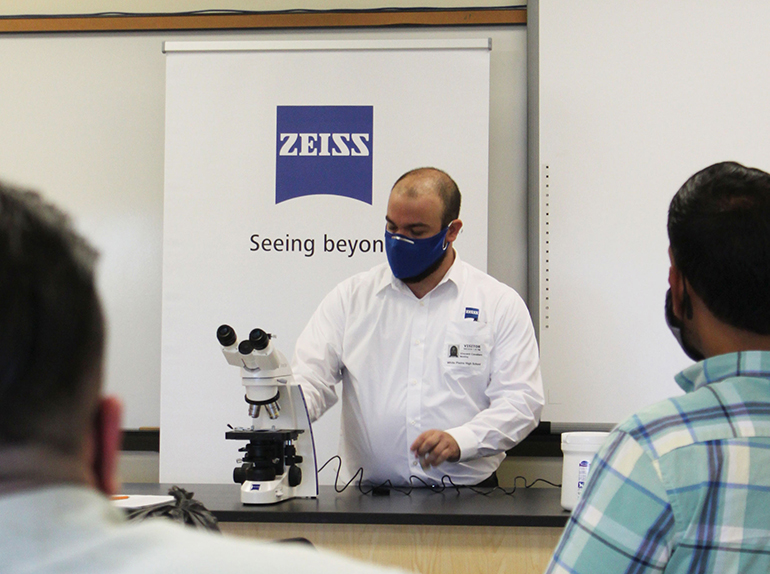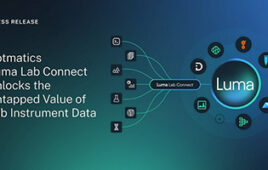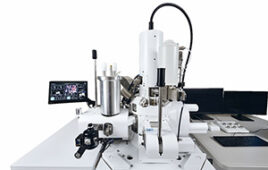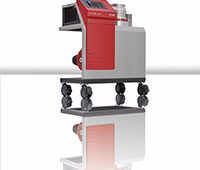Vincent “Vinnie” Cavaliere had an epiphany one day in study hall. He was a sophomore at East Hartford High School in East Hartford, Conn., reading chapter 8 of a science textbook. He remembers it vividly — because that was when he realized he loved chemistry.
More importantly, he realized he loved microscopes.
Two decades later he’s working with microscopes every day as the Product Marketing Manager for Educational Microscopy for ZEISS Research Microscopy Solutions. In this position, he’s had the opportunity to give back to the school that molded him — and schools everywhere just like it. Cavaliere brings his past and present together leading ZEISS’ donations of top-of-the-line microscopes and cameras through the Science Classroom Outreach Program for Educators (SCOPEs) Grant program.
Combining humor and science
Cavaliere’s growing fascination with scientific research and microscopes was nurtured by two key figures in his life.
The first was Tim Reid, his science teacher at East Hartford High School. “Mr. Reid was my science teacher for two years, including for AP Chemistry,” said Cavaliere. “He was a really inspirational figure. Mr. Reid always took the time to work with me individually to help me understand material formations and chemical phenomena.”
 The other influential figure was Michael Abelon, a biology teacher at East Hartford High School who liked to incorporate humor into his lessons. “He always had me cracking up comparing macrophages to Mack Trucks,” said Cavaliere. “He made science fun, but he also pushed you to investigate. He wouldn’t just tell us the right answer, but he would have us test and test until we found the answers for ourselves.”
The other influential figure was Michael Abelon, a biology teacher at East Hartford High School who liked to incorporate humor into his lessons. “He always had me cracking up comparing macrophages to Mack Trucks,” said Cavaliere. “He made science fun, but he also pushed you to investigate. He wouldn’t just tell us the right answer, but he would have us test and test until we found the answers for ourselves.”
Abelon was so dedicated to education that he co-founded the Connecticut IB (International Baccalaureate) Academy, a magnet school that shares the same campus with East Hartford High School. Abelon died of pancreatic cancer in 2005, but his legacy lives on in many of his former students.
Cavaliere adopted his former mentors’ same styles when he teaches — as a graduate-school teacher’s assistant at Indiana University Bloomington, as a trainer of light microscopy for ZEISS and teaching ZEISS-supported microscopy courses at the Marine Biological Laboratories in Woods Hole, Mass.
His passion for chemistry and microscopes also led him to help develop the ZEISS SCOPEs Grant in 2020. The program was designed to help teachers keep up with technology during the pandemic.
Cavaliere reached out to Reid, now retired but serving as the Founding Chairperson of the East Hartford Alumni Association and Education Foundation. Reid helped Cavaliere coordinate the donation of a new ZEISS microscope to East Hartford High School through the SCOPEs Grant — just one of many donations he’s had the honor of coordinating.
How does the SCOPEs program work?
ZEISS is well-known at the college level but has been taking steps to bring its technology to the K–12 world. Science is hands-on, and students can’t do chemistry labs at home. ZEISS was motivated to bring the in-person classroom experience to the digital classroom for students working remotely.
“We were trying to think of a way to get microscopes in the hands of more K–12 teachers while helping more students,” said Cavaliere. He and his team received insights for the program from Michael Blueglass, the president and co-founder of the Westchester Science & Engineer Fair (WESEF). “He provided really great insight into the high school teacher psyche — what they need and how this technology could help,” said Cavaliere.
“ZEISS recognized that many teachers across the country are facing the new challenge of educating students through remote learning or learning in the classroom with a bit more distance between teachers and students,” says Joseph Huff, head of marketing, North America at ZEISS Microscopy. “The necessity of creative lesson planning is key in science classrooms. Future scientists need hands-on laboratories and live demonstrations that add value to the traditional lecture format.”
The SCOPEs Grant program covers a complete ZEISS classroom microscope package with an optical microscope, a ZEISS Axiocam 208 8-megapixel color microscope camera and Labscope imaging software. Schools can apply for the grant and recipients can choose from two microscope models: ZEISS Primostar 3 or ZEISS Stemi 305.
SCOPEs started as a regional pilot for schools near the ZEISS North American corporate office in White Plains, N.Y., and is now available across the country. Central High School in Phoenix, Ariz., and Medomak High School in Waldoboro, Maine, were the first two recipients. The program will continue accepting applications through September.
Looking at his own experience, Cavaliere contacted his alma mater because he also wanted to reach students like him in high school. He knew East Hartford High School doesn’t always look for these kinds of purchases, but that the microscope donation would expand access to science for students. “We’re an urban, comprehensive high school,” says Melissa Gavarrino, Secondary Science Supervisor at East Hartford High School. “Serendipitous events like this aren’t always on our radar. We’re always searching for ways to work outside our budget, so we were surprised and delighted when Vinnie contacted us.”
SCOPEs in the classroom
The SCOPEs Grant for East Hartford High School was awarded to Tyler Hoxley, a science teacher at the school. He and Gavarrino chose the ZEISS Primostar 3 because of its ability to image a wide range of biological samples and the flexibility for other applications. Hoxley has been teaching science at the high school for nearly three decades and looks forward to incorporating the high-quality microscope into his sophomore biology, junior and senior anatomy, and physiology and advanced placement courses.
“We’re always aiming to move towards Next Generation Science Standards (NGSS),” says Hoxley, speaking of a multi-state effort toward more robust science education. “Although I didn’t know Vinnie when he was at East Hartford High School, I know that Tim Reid and the science department at the time were using microscopes that were quite old.”
Hoxley’s classroom was becoming more technology-focused even before COVID. Keeping pace with the NGSS means making hypotheses, finding evidence and providing reasoning with cutting-edge equipment and techniques. Students need the means to research and analyze data sets, develop and use models, and participate in argument-driven inquiry investigations. True scientific explanations were difficult with decades-old microscopes and have been nearly impossible with distance-learning. “Generating images of tissue samples is a time-consuming process,” says Hoxley. “Science is observational. You never know if you’re keeping the students’ attention without the hands-on interaction of the classroom.”
Although ZEISS Primostar 3 can be used to facilitate online learning, Hoxley knows it will also engage students in the classroom when students are back in the fall. Hoxley wants to enhance face-to-face teaching by using the network-compatible microscope to share images for a whole classroom up on a projector or SMART Board with the touch of a finger. “The advantage of a digital classroom is the students are seeing the correct aspect of a sample because they’ll be seeing what I’m seeing,” he says. Teachers can also use the system to record high-resolution, shareable images, videos and reports.
The district plans to train other teachers and departments on the microscope. “The district is good at providing professional development, so our staff will be experts in no time,” says Gavarrino. “The Allied Health program, in particular, will really profit from working with such state-of-the-art equipment before college. Our students looking to get into the health field after high school deserve the leg up!”
Giving every student a chance
Cavaliere is proud of what the SCOPEs Grant has accomplished so far. He’s excited to continue spreading the word about the program and to help build exciting new partnerships with schools and other organizations. SCOPEs has helped him make connections with others who can reach more students — like Dr. Michelle Oakley of the National Geographic show Yukon Vet, who is spreading the word among teachers in Canada and Alaska, and BioEYES Baltimore, an outreach program for under-resourced schools.
“ZEISS wants to give every student the chance to have the same epiphany I had all those years ago,” said Cavaliere. “I love science, and I want to spread that love around.”
The deadline for the ZEISS SCOPEs Grant is September 30, 2021. Do you want to upgrade your science students’ experience at home and in the classroom? Apply for the SCOPEs Grant here.







Tell Us What You Think!